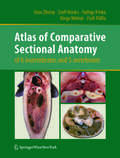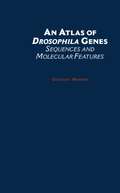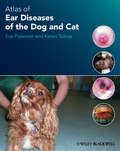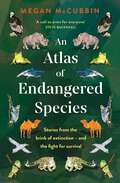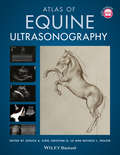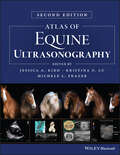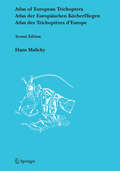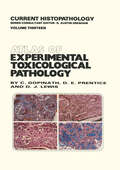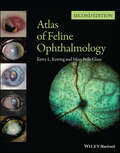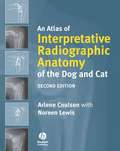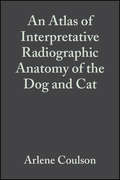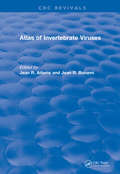- Table View
- List View
Atlas of Comparative Sectional Anatomy of 6 invertebrates and 5 vertebrates
by Géza Zboray Zsolt Kovács György Kriska Kinga Molnár Zsolt PálfiaThis atlas contains 189 coloured images taken from transversal, horizontal and sagittal sections of eleven organisms widely used in university teaching. Six invertebrate and five vertebrate species – from the nematode worm (Ascaris suum) to mammals (Rattus norvegicus) – are shown in detailed images.Studying the macrosections with unaided eyes, with a simple magnifier or binocular microscope might be of great help to accomplish traditional anatomical studies and to establish a certain spatial experience/space perception.This volume will be of great interest for biology students, researchers and teachers of comparative anatomy. It might act as supporting material of practical courses. Furthermore, medical practitioners, agricultural specialists and researchers having an interest in comparative anatomy might also benefit from it.
Atlas of Dental Radiography in Dogs and Cats
by Gregg A. DuPont Linda J. DeBowesIs it ever appropriate to diagnose and treat oral and dental problems without knowing the full extent of the problem? With more than 50% of anatomical structures and associated pathologies located below the gingivae and unseen to the eye, that's the reality without the use of high-quality, accurately interpreted radiographs. Atlas of Dental Radiography in Dogs and Cats presents hundreds of actual radiographic images, which are clearly labeled to facilitate accurate identification of normal and abnormal features. This valuable new atlas shows you exactly how to correlate common dental conditions with radiographic signs. Radiographs are also compared side by side with actual anatomical photographs to confirm surface landmarks visible on the radiographs. Correct positioning techniques for producing diagnostic radiographs as well as helpful tips and pitfalls when obtaining quality radiographs are logically presented. This approach helps you produce consistently high-quality radiographs, sharpen your interpretive skills, and confidently treat a wide range of dental problems. - Presents the most logical and useful approach to dental and oral radiography, using actual anatomical photographs for accurate clinical correlation - Depicts original and color-labeled radiographs side-by-side for accurate identification of normal and abnormal structures - Helps both veterinarians and technicians take the best possible radiographs, interpret them accurately, make sound treatment decisions, and monitor results - Provides clear, technical guidance for taking quality radiographs and identifying artefacts and results of improper imaging technique and film development - Presents clear pictorial instructions – from 2 angles – for correct positioning of the X-ray beam and intraoral films - Offers new opportunities for expanded professional services and revenues in your practice - Provides proof of compliance with standards of care for medical record documentation, helping you legally protect yourself, your staff, and your practice
Atlas of Diagnostic Pathology in Nonhuman Primates
by Andrew D. Miller Ivanela Kondova-Perseng Keith G. MansfieldThe Atlas of Diagnostic Pathology in Nonhuman Primates offers the first extensively illustrated collection of classic lesions in nonhuman primate diseases and pathological conditions, compiled by an international team of expert contributors. Organized by infectious and noninfectious conditions, the atlas comprehensively covers viral, bacterial, fungal, and parasitic diseases, as well as nutritional, toxic, and metabolic causes, and genetic, age-related, neoplastic, and noninfectious inflammatory conditions. Since nonhuman primates are an indispensable resource for efficacy and safety evaluation of novel therapeutic strategies targeting clinically important human diseases, research with monkeys is critical to understand how to prevent and treat emerging infectious diseases such as Zika virus disease, Ebola, Middle East Respiratory Syndrome (MERS), COVID-19/SARS-CoV-2/coronavirus, pandemic flu, and many more. This book is intended to serve veterinary practitioners in university facilities, zoos, biotechnological and pharmaceutical companies, as well as clinicians, researchers, and students engaged in nonhuman primate research.
Atlas of Ear Diseases of the Dog and Cat
by Sue Paterson Karen TobiasBringing together a wealth of images of normal and diseased dog and cat ears, this is an indispensible diagnostic tool for the small animal veterinary practitioner seeing ear cases on a regular basis. This fully illustrated atlas covers the anatomy of the canine and feline ear, diagnostic techniques, a range of commonly seen diseases, and ear surgery. Atlas of Ear Diseases of the Dog and Cat is one of the most complete picture references for this rapidly expanding branch of small animal medicine and surgery. It is an invaluable aid for general practitioners, as well as those specialising in dermatology, and serves as an effective revision aid for veterinary students and those studying for further qualifications in veterinary dermatology. Includes over 400 high quality colour clinical images and clear line drawings Images are accompanied by clear explanatory text throughout Enables veterinarians to match cases seen in practice with photos supplied to aid diagnosis Written by highly qualified specialist veterinary dermatologist and veterinary surgeon
Atlas of Ear Diseases of the Dog and Cat
by Sue Paterson Karen TobiasBringing together a wealth of images of normal and diseased dog and cat ears, this is an indispensible diagnostic tool for the small animal veterinary practitioner seeing ear cases on a regular basis. This fully illustrated atlas covers the anatomy of the canine and feline ear, diagnostic techniques, a range of commonly seen diseases, and ear surgery. Atlas of Ear Diseases of the Dog and Cat is one of the most complete picture references for this rapidly expanding branch of small animal medicine and surgery. It is an invaluable aid for general practitioners, as well as those specialising in dermatology, and serves as an effective revision aid for veterinary students and those studying for further qualifications in veterinary dermatology. Includes over 400 high quality colour clinical images and clear line drawings Images are accompanied by clear explanatory text throughout Enables veterinarians to match cases seen in practice with photos supplied to aid diagnosis Written by highly qualified specialist veterinary dermatologist and veterinary surgeon
An Atlas of Endangered Species
by Megan McCubbin'A call to arms for everyone' Steve BackshallThe diversity of life on earth is astounding, with each species perfectly adapted to its environment. Sharks can navigate the ocean using electromagnetic fields; sloths use algae as camouflage; albatross can fly for hours without beating their wings; and orca pods each have unique cultures and languages. But every hour, three species disappear. Our incredible world is at risk.Megan McCubbin reveals the stories of the scientists, rangers and conservationists who are fighting to save these extraordinary creatures from extinction. An Atlas of Endangered Species shows us that the battle is on for their survival - and we all have a part to play.'Joyful and heartbreaking, an inspiring celebration of some of our planet's most endangered species and those who champion them' - Dave Goulson, author of Silent Earth'A powerful, passionate plea for a wilder future' - Sophie Pavelle, author of Forget Me Not
Atlas of Entomopathogenic Fungi
by Robert A. Samson Harry C. Evans Jean-Paul LatgeBiological insecticides are competing more and more with traditional chemical pesticides. A successful application of natural pathogens requires a better understanding of both fungal and insect ecology and physiology. This Atlas provides a comprehensive overview of these fields and includes the taxonomy of those species of fungi which are proven pathogens. Biotechnological methods for the genetic modification of these natural pathogens resulting in further optimization and the advantages of biological control are discussed.
Atlas of Equine Ultrasonography
by Jessica A. Kidd Kristina G. Lu Michele L. FrazerThe only visual guide to equine ultrasonography based on digital ultrasound technology. Atlas of Equine Ultrasonography provides comprehensive coverage of both musculoskeletal and non-musculoskeletal areas of the horse. Ideal for practitioners in first opinion or referral practices, each chapter features normal images for anatomical reference followed by abnormal images covering a broad range of recognised pathologies. The book is divided into musculoskeletal, reproductive and internal medicine sections and includes positioning diagrams demonstrating how to capture optimal images. With contributions from experts around the world, this book is the go-to reference for equine clinical ultrasonography. Key features include: Pictorially based with a wealth of digital ultrasound images covering both musculoskeletal and non-musculoskeletal areas and their associated pathologies. Each chapter begins with a discussion of normal anatomy and demonstrates how to obtain and interpret the images presented. A video library of over 50 ultrasound examinations is available for streaming or download and viewing on-the-go. Access details are provided in the book.
Atlas of Equine Ultrasonography
by Jessica A. Kidd Kristina G. Lu Michele L. FrazerThe only visual guide to equine ultrasonography based on digital ultrasound technology. Atlas of Equine Ultrasonography provides comprehensive coverage of both musculoskeletal and non-musculoskeletal areas of the horse. Ideal for practitioners in first opinion or referral practices, each chapter features normal images for anatomical reference followed by abnormal images covering a broad range of recognised pathologies. The book is divided into musculoskeletal, reproductive and internal medicine sections and includes positioning diagrams demonstrating how to capture optimal images. With contributions from experts around the world, this book is the go-to reference for equine clinical ultrasonography. Key features include: Pictorially based with a wealth of digital ultrasound images covering both musculoskeletal and non-musculoskeletal areas and their associated pathologies. Each chapter begins with a discussion of normal anatomy and demonstrates how to obtain and interpret the images presented. A video library of over 50 ultrasound examinations is available for streaming or download and viewing on-the-go. Access details are provided in the book.
Atlas of Equine Ultrasonography
by Jessica A. Kidd Kristina G. Lu Michele L. FrazerATLAS OF EQUINE ULTRASONOGRAPHY A THOROUGH EXPANSION TO THE FIRST ATLAS OF ULTRASONOGRAPHY IN THE HORSE, WITH NEW AND SIGNIFICANTLY IMPROVED IMAGES Ultrasonography is a vital diagnostic tool that can be applied in numerous functions in a veterinary practice. In conjunction with relevant clinical information—patient history and physical examination findings, for example—it can act as an important aid in the veterinarian’s decision-making process. Many vets in equine practice rely upon ultrasonography as a mainstay of equine diagnostic imaging on a wide range of structures and body systems. Ultrasonography is a useful procedure that is non-invasive and acts in complement to radiography to successfully diagnose the animal’s condition. This book’s aim is to encourage the clinician to rely further on the use of ultrasonography in their practice. The second edition of Atlas of Equine Ultrasonography provides an updated and expanded revision of the first atlas of ultrasonography in the horse. The first edition of this important resource was the first pictorially-based book to cover ultrasonography in the horse, and remains the only book currently available on the subject. The current version offers 450 additional images with greater clarity and precision in the images throughout and demonstrates how to obtain images in each body region while offering clinical ultrasonograms that show pathology. Atlas of Equine Ultrasonography readers will also find: High-quality clinical ultrasonograms for important musculoskeletal, reproductive, and medical conditions in the horse More than 1,500 images, with accompanying concise text describing the images A companion website that provides video clips showing dynamic ultrasound exams Atlas of Equine Ultrasonography is an invaluable reference to any veterinarian evaluating ultrasonograms in equine patients. As a result, this book will be of particular interest to equine specialists, veterinary radiologists, equine practitioners, and veterinary students.
Atlas of Equine Ultrasonography
by Jessica A. Kidd Kristina G. Lu Michele L. FrazerATLAS OF EQUINE ULTRASONOGRAPHY A THOROUGH EXPANSION TO THE FIRST ATLAS OF ULTRASONOGRAPHY IN THE HORSE, WITH NEW AND SIGNIFICANTLY IMPROVED IMAGES Ultrasonography is a vital diagnostic tool that can be applied in numerous functions in a veterinary practice. In conjunction with relevant clinical information—patient history and physical examination findings, for example—it can act as an important aid in the veterinarian’s decision-making process. Many vets in equine practice rely upon ultrasonography as a mainstay of equine diagnostic imaging on a wide range of structures and body systems. Ultrasonography is a useful procedure that is non-invasive and acts in complement to radiography to successfully diagnose the animal’s condition. This book’s aim is to encourage the clinician to rely further on the use of ultrasonography in their practice. The second edition of Atlas of Equine Ultrasonography provides an updated and expanded revision of the first atlas of ultrasonography in the horse. The first edition of this important resource was the first pictorially-based book to cover ultrasonography in the horse, and remains the only book currently available on the subject. The current version offers 450 additional images with greater clarity and precision in the images throughout and demonstrates how to obtain images in each body region while offering clinical ultrasonograms that show pathology. Atlas of Equine Ultrasonography readers will also find: High-quality clinical ultrasonograms for important musculoskeletal, reproductive, and medical conditions in the horse More than 1,500 images, with accompanying concise text describing the images A companion website that provides video clips showing dynamic ultrasound exams Atlas of Equine Ultrasonography is an invaluable reference to any veterinarian evaluating ultrasonograms in equine patients. As a result, this book will be of particular interest to equine specialists, veterinary radiologists, equine practitioners, and veterinary students.
Atlas of European Trichoptera: Atlas der Europäischen Köcherfliegen / Atlas des Trichoptères d’Europe
by Hans MalickyCaddis flies are important indicators of environmental quality in aquatic biotopes. This Atlas is the first book which enables the identification of the entire European caddis fly fauna since McLachlan’s Revision and Synopsis of 1874-1880. Identification of European caddis flies has proved difficult as a result of the widely scattered literature, and has therefore been a matter for specialists for more than hundred years. This Second Edition of The Atlas of European Trichoptera contains over 1400 species which means an increase of 25% since the first edition of 1983. Identification of specimens is one of the most difficult tasks in Zoology. This volume presents information which will enable the reader to develop his own opinions and will also help him reach decisions concerning the accuracy of his own results. The identification of specimens is undertaken by comparing the detailed drawings of the most important characteristics of all species known in Europe, the Mediterranean countries north of the Sahara, the Canary islands, Madeira, the Azores islands and the adjacent eastern regions including the Arab Peninsula and Iran. The fauna of Turkistan and Siberia is partially included. Explanations of the drawings are provided mainly by symbols which enable the use of this book independent of language. This concept has been proved successful in University courses. The introductory chapters are in English, German and French. Should a reader not understand any of these languages, the translation of these few pages, including the pages of explanations, will provide sufficient understanding for the entire book.
Atlas of Experimental Toxicological Pathology (Current Histopathology #13)
by C. Gopinath D. Prentice D.J. LewisOur aim in producing a colour atlas of toxicological guidelines itemize the investigations to be carried out pathology was to present a catalogue of histopathologi during the course of the study and they normally include: cal lesions which we had encountered over the years in clinical observations and behaviour; food intake and body various laboratory animal species exposed to a vast weight measurements; serum biochemistry; haema range of pharmaceuticals, agrochemicals and industrial tology; ECG and ophthalmology. At the end of a study, chemicals. While we believe a colour atlas is the ideal full macroscopic and microscopic examinations of the way to share our experiences with others, it quickly organ weight analyses together with tissues are essen became clear to us that for the atlas to be meaningful tial. By far the greater part of the material used in this the associated text must be comprehensive and contain book is from toxicity studies conducted in recent years ample literature references. and performed in compliance with the Good Laboratory The atlas is intended for both the trainee and the Practice standards of governmental regulatory bodies in experienced toxicological pathologist working with lab Europe, Japan and North America. oratory animals in the pharmaceutical, agrochemical or Toxicity studies are commonly carried out in rats, chemical environment.
Atlas of Feline Ophthalmology
by Kerry L. Ketring Mary Belle GlazeSuccessful management of eye disease relies on the veterinarian’s ability to identify ocular features and distinguish pathologic changes. Atlas of Feline Ophthalmology, Second Edition is an invaluable diagnostic reference, providing high-quality color photographs for comparison with a presenting complaint. Presenting 394 photographs illustrating both normal and pathologic ocular conditions, this Second Edition offers a current, complete reference on ocular diseases, adding conditions recognized since publication of the first edition, a broader geographic scope, and many new images with improved quality. Carefully designed for easy reference, the contents are divided into sections corresponding to specific anatomical structures of the eye. A useful appendix new to this edition groups figures by etiology, making it easy to find every image associated with a specific agent or disease. Atlas of Feline Ophthalmology, Second Edition is a useful tool aiding general practitioners in diagnosing eye disease in cats.
Atlas of Feline Ophthalmology
by Kerry L. Ketring Mary Belle GlazeSuccessful management of eye disease relies on the veterinarian’s ability to identify ocular features and distinguish pathologic changes. Atlas of Feline Ophthalmology, Second Edition is an invaluable diagnostic reference, providing high-quality color photographs for comparison with a presenting complaint. Presenting 394 photographs illustrating both normal and pathologic ocular conditions, this Second Edition offers a current, complete reference on ocular diseases, adding conditions recognized since publication of the first edition, a broader geographic scope, and many new images with improved quality. Carefully designed for easy reference, the contents are divided into sections corresponding to specific anatomical structures of the eye. A useful appendix new to this edition groups figures by etiology, making it easy to find every image associated with a specific agent or disease. Atlas of Feline Ophthalmology, Second Edition is a useful tool aiding general practitioners in diagnosing eye disease in cats.
Atlas of Inherited Retinal Diseases (Advances in Experimental Medicine and Biology #1085)
by Tarun Sharma Stephen H. TsangThis Atlas of Inherited Retinal Disorders provides a thorough overview of various inherited retinal dystrophies with emphasis on phenotype characteristics and how they relate to the most frequently encountered genes. It also meets the previously unmet needs of PhD students who will benefit from seeing the phenotypes of genes they work on and study. Further, because genetic-testing costs are quite high and spiraling higher, this Atlas will help geneticists familiarize themselves with the candidate gene approach to test patients’ genomes, enabling more cost-efficient testing. This invaluable atlas is organized into eight sections starting with an introduction to the basic knowledge on retinal imaging, followed by diseases listed according to inheritance pattern and disorders with extraocular manifestations grouped by defining features. This structure will be intuitive to clinicians and students studying inherited retinal disorders.
An Atlas of Interpretative Radiographic Anatomy of the Dog and Cat
by Arlene CoulsonThis is the definitive reference for the small animal practitioner to normal radiographic anatomy of the cat and dog. With over forty years of experience between them, the authors have produced an invaluable reference atlas for the veterinary practitioner. The book is suitable for the general and referral based practitioner, undergraduate or postgraduate veterinary surgeon. Over 550 radiographic images analysed and explained More than 50 new figures added, with the quality of existing images enhanced Revised contents and page headers for easy-reference Clear informative line drawings to trace radiographic shadows and schematic drawings of underlying structures not seen in plain radiographs.
An Atlas of Interpretative Radiographic Anatomy of the Dog and Cat
by Arlene CoulsonThis is the definitive reference for the small animal practitioner to normal radiographic anatomy of the cat and dog. With over forty years of experience between them, the authors have produced an invaluable reference atlas for the veterinary practitioner. The book is suitable for the general and referral based practitioner, undergraduate or postgraduate veterinary surgeon. Over 550 radiographic images analysed and explained More than 50 new figures added, with the quality of existing images enhanced Revised contents and page headers for easy-reference Clear informative line drawings to trace radiographic shadows and schematic drawings of underlying structures not seen in plain radiographs.
An Atlas of Interpretative Radiographic Anatomy of the Dog and Cat
by Arlene Coulson Noreen LewisA good basic knowledge of radiological anatomy is essential for both the specialising and non-specialising veterinary audience. This comprehensive and general practice orientated reference book which provides detailed radiographic guidance on the normal clinical anatomy of the dog and cat. In addition to numerous projections of plain and contrast studies, this atlas includes detailed observations of the normal range of variations seen in the juvenile animal, differences between breeds and descriptions of the range of anatomical variations commonly encountered in veterinary practice. The clinical utility of the book has been greatly enhanced by the use of line drawings corresponding to the relevant radiographs and schematic drawings of those structures not normally visible in plain films. The authors, both with extensive teaching experience in postgraduate veterinary radiology, describe procedures and techniques routinely available in general veterinary practice. Monitored for anatomical accuracy throughout, this atlas provides a single volume reference for the general practitioner, undergraduate or postgraduate veterinary surgeon.
Atlas of Invertebrate Viruses (CRC Press Revivals)
by Jean R. Adams Jean R. BonamiThe Purpose of this book is to provide a helpful reference for invertebrate pathologist, virologists, and electron microscopists on invertebrate viruses. Investigators from around the world have shared their expertise in order introduce scientists to the exciting advances in invertebrate virology.
Atlas of Invertebrate Viruses: Atlas Of Invertebrate Viruses (1991) (CRC Press Revivals)
by Jean R. Adams Jean R. BonamiThe Purpose of this book is to provide a helpful reference for invertebrate pathologist, virologists, and electron microscopists on invertebrate viruses. Investigators from around the world have shared their expertise in order introduce scientists to the exciting advances in invertebrate virology.
An Atlas of Mammalian Chromosomes: Volume 1
by Tao C. Hsu Kurt BenirschkeIn recent years, because of advances in karyological techniques, we have witnessed a remarkable renewal of interest in studies of mammalian chromosomes. These techniques, generally involving the use of tissue culture, colchicine and hypotonic solution pretreatments, allow for a much clearer display of metaphase chromosomes of mammalian cells than the classic direct squash or tissue section methods. Consequently, what was known about the chromosome complement of most mammals must be revised. The most astonishing revision, of course, was that made by Tjio and Levan in 1956, who demonstrated that the diploid number of man is 46, not 48 as previously believed. Similar revisions will have to be made for many other mammalian species, either in number or in karyotype structure. Many animals are being examined cytologically for the first time. The findings are now extensive and scattered; they appear in numer ous periodicals and newsletters, or they are kept in cytologists' file drawers without being published. It is difficult to have access to perti nent data for comparison among related species or for evaluation of various karyological characteristics within a karyotype. Such evaluations can be done only when reasonably uniform material is collected and placed side by side for comparison, accompanied by relative references. We considered that probably an Atlas of Mammalian Chromosomes would fulfill such a need. Needless to say, it is impossible to present karyotypes of all mam malian species at one time.
An Atlas of Mammalian Chromosomes: Volume 2
by Tao C. Hsu Kurt BenirschkeIn recent years, because of advances in karyological techniques, we have witnessed a remarkable renewal of interest in studies of mammalian chromosomes. These techniques, generally involving the use of tissue culture, colchicine and hypotonic solution pretreatments, allow for a much clearer display of metaphase chromosomes of mammalian cells than the classic direct squash or tissue section methods. Consequently, what was known about the chromosome complement of most mammals must be revised. The most astonishing revision, of course, was that made by Tjio and Levan in 1956, who demonstrated that the diploid number of man is 46, not 48 as previously believed. Similar revisions will have to be made for many other mammalian species, either in number or in karyotype structure. Many animals are being examined cytologically for the first time. The findings are now extensive and scattered; they appear in numer ous periodicals and newsletters, or they are kept in cytologists' file drawers without being published. It is difficult to have access to perti nent data for comparison among related species or for evaluation of various karyological characteristics within a karyotype. Such evaluations can be done only when reasonably uniform material is collected and placed side by side for comparison, accompanied by relative references. We considered that probably an Atlas of Mammalian Chromosomes would fulfill such a need. Needless to say, it is impossible to present karyotypes of all mam malian species at one time.
